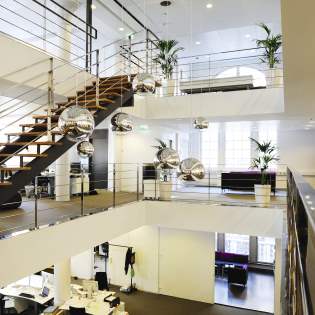Space Reconfiguration, Renovation, and Construction
Follow these sustainable strategies for space reconfiguration, renovation, and construction projects. Federal projects should meet or exceed the Guiding Principles for Sustainable Federal Buildings. Consider commercial building certification systems and standards that can help meet the Guiding Principles for Sustainable Federal Buildings and other sustainable federal building requirements. Refer to the Apply Section of SFTool for representative project case studies to discover key practices, benefits, results and checklists.
For sustainable strategies specific to non-office workspaces, such as cafeterias and labs, refer to the Explore Section.
Need more ideas? Use our tool to identify potential upgrades and energy conservation measures.
- Define the key sustainable strategies for the project early
- Gather a team of creative, dedicated professionals who spur new ideas and ensure a collaborative, integrative design process
- Engage occupants and other stakeholders during the design process to address their needs
- Detail sustainable strategies, materials, and practices in the construction documents and specifications
- Choose a green building, if relocating, with sustainable site attributes such as mass transit, services and amenities for occupants, and a property management company using sustainable practices
- Phase work, when renovating in place, to minimize potential for cross contamination between occupied and construction areas
- Limit permanent walls to functional areas such as restrooms, storage, or data rooms and place them in the core of the building
- Consider movable walls for easy reconfiguration and reduction of construction waste
- Plan space layout to accommodate the interchangeability of private offices, conference rooms, teaming spaces, and open office space
- Provide furniture, including in conference rooms and shared space, that can be easily adjusted, reconfigured and modified
For Building Systems (Mechanical, Electrical, Plumbing, Acoustic Systems), refer to Building Systems Upgrades
- Include commissioning of the building envelope in the commissioning plan to identify areas of concern such as air and water infiltration
- Use energy modeling/simulation tools to account for building orientation, solar exposure, climate conditions and building envelope performance when considering building materials and exterior glazing
- Implement passive daylighting strategies such as exterior shades, overhangs, vertical fins and light shelves to allow daylight to penetrate into the building floorplate while controlling glare and heat gain
- Install high R-value insulation for walls and other opaque elements of the building envelope and ensure a continuous and sealed thermal and air barrier
- Consider building integrated photovoltaic (BIPV) panels and/or solar shading system as a way of generating on-site, renewable energy
- Consider light sensors to control perimeter lighting levels when adequate daylight is available to reduce power and HVAC loads
- Optimize energy performance:
- Install a high reflectance roof, also known as a high albedo, white, or cool roof, made of light-colored materials that reflect sunlight and heat away from the building
- Select ENERGY STAR certified roof products
- Consider a planted roof, which uses plants as a technology to provide insulation, absorb heat and water, and serve as a garden
- Consider photovoltaic (PV) panels that convert light from the sun into usable direct current (DC)
- Consider solar hot water heating to meet hot water demand, if lifecycle cost-effective

- Follow federal environmental and energy guidelines for product and service purchases
- Select products and materials having environmentally preferable attributes as certified by a third party, and locally sourced where possible
- Consider reusing durable elements and materials when renovating spaces
- Select local materials and artifacts to create a workplace grounded in the regional ecology and community
- Minimize waste
- Consider products, such as carpet and acoustical ceiling tile, from manufacturers with Extended Producer Responsibility (EPR), or take-back, programs
- Maximize access to daylight:
- Phase construction so that absorptive materials, such as carpet and acoustical ceiling tile, are installed after an off-gassing period when wet finishes, such as paint, have dried and solvents have cured
- Use salvaged or reused materials that no longer emit volatile organic compounds (VOCs)
- Use inherently non-emitting materials (those that contain no organic chemical binders, surface coatings, or sealants)
- Consider products and materials, and/or installation methods, that do not require adhesives
- Use paints and coatings that meet the California Air Resource Board (CARB) Suggested Control Measure (SCM) for Architectural Coatings
- Use adhesives and sealants that meet South Coast Air Quality Management District (SCAQMD) Rule 1168
- Use cleaning chemicals and solutions having environmentally preferable attributes as certified by a third party
- Select durable, water-resistant, and easily cleanable flooring materials in areas with water use
- Design for modularity and flexibility:
- Consider a raised access floor with under floor air distribution to enable user control of ventilation and increase flexibility for future space reconfiguration
- Consider modular flooring products, such as carpet tile and resilient floor tile, as opposed to sheet goods, to enable targeted replacement in high traffic areas and reduction of waste when reconfiguring space
- Protect Indoor Environmental Quality:
- Install entryway systems with recessed grates and/or ‘walk-off’ mats to prevent dirt and debris from entering the space
- Consider pre-finished non-carpet products to reduce off-gassing on site
- Manage sound to increase comfort and worker productivity:
- Protect Indoor Environmental Quality:
- Select Green Label Plus
 products certified as low-emitting by the Carpet and Rug Institute (CRI)
products certified as low-emitting by the Carpet and Rug Institute (CRI)
- Maximize product and material longevity:
- Dry vacuum regularly and follow with a wet vacuum water extraction machine to protect indoor air quality (IAQ)
- Prevent stains by cleaning up spills promptly, starting with cold water and blotting cloths
- Design for modularity and flexibility:
- Limit permanent walls to functional and support areas such as restrooms, storage, or data rooms and place them in the core of the building
- Consider movable walls for easy reconfiguration and reduction of construction waste
- Maximize access to daylight and views:
- Protect Indoor Environmental Quality:
- Manage sound to increase comfort and worker productivity:
- Minimize waste
- Consider leaving ceilings unfinished in unoccupied spaces
- Consider products, such as acoustical ceiling tile, from manufacturers with Extended Producer Responsibility (EPR), or take-back, programs
- Maximize access to daylight:
- Protect Indoor Environmental Quality:
- Manage sound to increase comfort and worker productivity:
- Minimize waste:
- Consider standard sizes to minimize cost and enable future reuse
- Use salvaged or reused materials wherever possible
- Protect Indoor Environmental Quality:
- Select composite wood products certified as ultra-low-emitting formaldehyde (ULEF) or no added formaldehyde resins (NAF) under EPA Toxic Substances Control Act, Formaldehyde Emission Standards for Composite Wood Products (EPA TSCA Title VI) or California Air Resources Board (CARB) Airborne Toxic Control Measure (ATCM)
- Consider countertop materials that do not need to be sealed regularly
- Select durable wall base products and materials that reduce wear and tear on wall surfaces
- Consider wall panels, chair rails and corner guards in high traffic spaces to reduce wear and tear on wall surfaces
- Maximize access to daylight:
- Protect Indoor Environmental Quality:
- Select paints and coatings that meet the California Air Resource Board (CARB) Suggested Control Measure (SCM) for Architectural Coatings
- Select adhesives and sealants that meet South Coast Air Quality Management District (SCAQMD) Rule 1168
- Select light colored paint to avoid the volatile organic compounds (VOCs) that are often added when tinting paint
- Schedule painting work after hours when renovating occupied space
- Phase construction so that painting is complete before absorptive materials, like carpet and acoustical ceiling tiles, are installed
- Provide an exercise room or access to a workout facility
- Encourage use of stairwells through wayfinding and motivational signs
- Enhance the appeal of exercise rooms and stairwells using design features such as a music system, creative lighting, temperature conditioning, bright colors, or artwork
- Provide a mix of work zones, as well as adjustable, reconfigurable furniture, to accommodate a variety of tasks and functions, including both concentration and collaboration activities, as well as conversations demanding privacy
- Provide access to outdoor space amenities, such as outdoor seating, outdoor fitness areas, gardens or greenspace, walking trails, or water features
- Provide a break area that supports social interaction and encourages employees to step away from their desks during the workday
- Provide space for respite, relaxation, meditation, and health programs
- Provide active workstations with adjustable height work surfaces
- Provide task chairs with adjustments for seat/back tension; seat height, depth and tilt; and arm height (separate from seat height)
- Ensure all computer equipment components are adjustable
References/Resources


 and LEED Reference Guide for Green Interior Design and Construction
and LEED Reference Guide for Green Interior Design and Construction
 (access requires creating an account)
(access requires creating an account)

